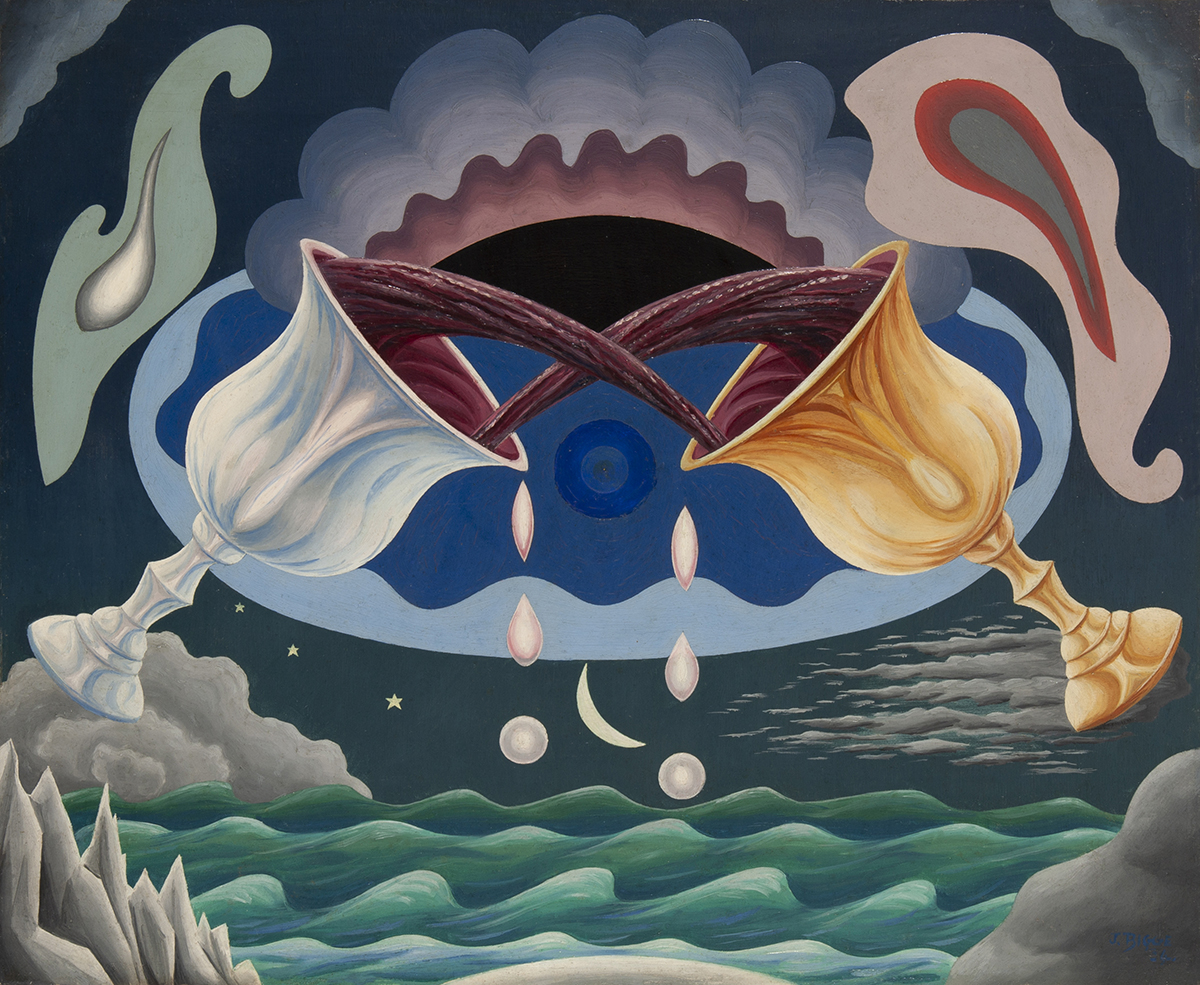
PRESS RELEASE
JOHN and RUTH SELBY-BIGGE: From the Slade to Surrealism
3–20 December 2025
England & Co in residence at the Great Pultney Street Gallery
36 Great Pulteney Street, London W1F 9NS
Opening hours: Monday-Friday 11am-5.30pm / Saturdays 11am-5pm / & by appointment
John and Ruth Selby-Bigge were British artists who met at the Slade in 1913 and married a year later. This is the first time their works have been exhibited together.
Rachel (Ruth) Humphries (1892-1962) was the daughter of a founder of the Lund Humphries publishing company and a promising star student at the Slade. She was awarded four major prizes, including first prize for the Slade School’s Summer Composition Competition in 1912-13 for her large painting, A Group of Figures Standing in a Landscape (UCL Art Collection), and was much admired by fellow students Mark Gertler and Edward Wadsworth. She became a close friend of Dora Carrington and mixed in Bloomsbury circles, described by Virginia Woolf as ‘the beautiful Ruth Humphries’. John Selby-Bigge (1892-1973) and Ruth married in July 1914 and soon afterwards he left the Slade to serve as a Lieutenant with the Royal Army Service Corp during the First World War.
In the late 1920s, John Selby-Bigge became an active member of the Surrealist group of artists through his friendships with Edward Wadsworth, Tristram Hillier and Paul Nash, whom he had met through his wife. Wadsworth encouraged his painting and had already introduced him to Surrealism and the ‘new currents in Paris’. A 1928 exhibition of works by Giorgio de Chirico at the Arthur Tooth Gallery in London provided further inspiration.
Surrealism gave John Selby-Bigge ‘a line of development’, and visits to London’s Science Museum gave him visual material of ‘fantastic forms, such as sections of ships and pieces of machinery’. Paul Nash suggested that he should exhibit his paintings and in April 1931, John Selby-Bigge’s first exhibition was held in London at the Wertheim Gallery, paired with a solo exhibition of works by John Banting. This was followed that same year by a solo exhibition at Galerie Vignon in Paris, a successful exhibition with a vernissage attended by Gertrude Stein. He had worked at various jobs post-war, but was now regularly invited to contribute to mixed exhibitions in London, including Tooth’s Galleries’ annual presentations of Recent Developments in British Painting, usually alongside Wadsworth, Nash, Ben Nicholson, Henry Moore and Tristram Hillier.
By the 1920s, Ruth Selby-Bigge no longer had the opportunity to paint as she was immersed in looking after their three daughters, their first-born daughter having died in 1919. They had moved from the country to Oxford and London and he worked for a time at her family’s firm, Lund Humphries, running their London studio and working with the Design Director, Edward McKnight Kauffer and the avant garde photographers Man Ray and Francis Bruguière. John Selby-Bigge became ‘absorbed in the problems of Abstract art’ and studied ‘esoteric philosophy and modern physics’ and in 1933, became a founding member of Unit One at the invitation of Paul Nash. This new group was composed of painters, sculptors and architects, well known in the modern movement although working independently. The first Exhibition of Unit One was held at the Mayor Gallery, London in April that year, and subsequently toured museums around the UK.
John Selby-Bigge painted as ‘John Bigge’ and took part in the first exhibition of Surrealism in England: Surrealism, The International Surrealist Exhibition at the New Burlington Galleries in the Summer of 1936. It was his only formal acknowledgement of his involvement in Surrealism.
In 1936, the family moved to Austria, but by 1937, they had moved to rural France, settling into an old manor house not far from where Gertrude Stein and Alice Toklas were living. Stein and Toklas became became their good friends, and Alice continued to correspond occasionally with Ruth into the 1950s.
With war imminent, the family left France for Portugal. In Lisbon, John Selby-Bigge met his future second wife, and Ruth Selby-Bigge returned to England with their daughters in 1941 with their divorce finalised in 1944. John Selby-Bigge worked with the British Red Cross in Italy and Austria and was awarded the OBE in 1946. From the late 1940s, he lived in Spain and then in the Dordogne, France. He became the second Baronet of Kings Sutton on the death of his father in 1951.
By the end of the 1940s, Ruth Selby-Bigge was living in a converted barn on the Selby-Bigge estate and bringing up her two grandsons. She began to paint again, and by the early 1950s had produced works for an exhibition held in the gallery of a London department store. These relatively small, atmospheric paintings harked back to the Surrealist interests she had shared with her husband and that had developed through her friendships with Wadsworth, Nash, and Hillier: a gentle, lyrical form of Surrealism displaying her interest in the natural world.
Her still-life subjects, usually of closely observed plants and vegetables were presented large-scale in the foreground with distant landscapes or beaches beyond. Others featured seashells and exotic fragments of coral and quartz sent by her daughter Diana who had moved to the far northern coast of Australia. Ruth sold very few works, but continued to work quietly without any serious opportunities to exhibit. This exhibition, where her works are presented for the first time alongside those of her husband, is the first formal exhibition of her work since her time as an acclaimed, prize-winning student at the Slade.
John Selby-Bigge’s works are held in numerous public collections including Tate, Southampton City Art Gallery, Ferens Art Gallery, Leeds Art Gallery and MIMA, Middlesborough. His work was most recently seen in Forbidden Territories: 100 Years of Surreal Landscapes at the Hepworth Wakefield in 2024-25.
